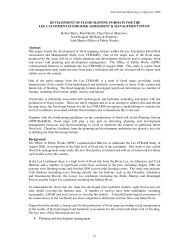Vegetation (Floating River Vegetation) - Office of Public Works
Vegetation (Floating River Vegetation) - Office of Public Works
Vegetation (Floating River Vegetation) - Office of Public Works
Create successful ePaper yourself
Turn your PDF publications into a flip-book with our unique Google optimized e-Paper software.
(Ranunculus) species namely R.penicillatus ssp. Pseud<strong>of</strong>luitans, R.fluitans. If the above diversity is<br />
the typical trend across Europe, it explains the reasoning for emphasizing water crowfoot species<br />
when classifying habitat EU 2360, watercourses <strong>of</strong> plain to montane levels, with submerged or<br />
floating vegetation. The presence <strong>of</strong> R.penicillatus ssp. Pseud<strong>of</strong>luitans in five <strong>of</strong> the six groupings<br />
suggests that it is a species that has either successfully adapted to a number <strong>of</strong> different riverine<br />
habitats or all watercourses have been subjected to substantially the same modification regime.<br />
To highlight and prevent the decline in floating river vegetation across the United Kingdom a series<br />
<strong>of</strong> Local Biodiversity Area Plans have been compiled identifying threats to aquatic vegetation and<br />
action to be taken to reduce loss. Threats to floating river vegetation include:<br />
•Modification <strong>of</strong> watercourse depth and flow.<br />
•Over abstraction <strong>of</strong> groundwater<br />
•Water quality, by agricultural run-<strong>of</strong>f, and cattle loafing and industrial pollution<br />
•Increase in suspended solids within the water column<br />
•Engineering and construction works<br />
•Physical damage to plants by human activity<br />
•Excessive shading by overgrown hedgerows especially on smaller watercourses.<br />
Modification <strong>of</strong> watercourses by changing width, depth and flow <strong>of</strong> rivers has contributed to<br />
an increase in siltation <strong>of</strong> some rivers during summer months as water levels drop.<br />
Over abstraction <strong>of</strong> groundwater can result in lower water levels and drier watercourses,<br />
increased risk <strong>of</strong> pollution and higher rates <strong>of</strong> siltation.<br />
Reduction in water quality and the nutrient loading <strong>of</strong> watercourses can favour the growth <strong>of</strong><br />
other aquatic vegetation. It has been reported that R.fluitans can tolerate slight pollution but is<br />
intolerant <strong>of</strong> water turbidity (Northern Ireland Species Action Plan).<br />
Engineering work including the building <strong>of</strong> bridges and reservoirs can alter the flow <strong>of</strong><br />
watercourses. It has suggested that the use <strong>of</strong> concrete and cement components in aquatic<br />
environments impacts on the physical and chemical characteristics <strong>of</strong> watercourses (Hatton-Ellis &<br />
Grieve, 2003).<br />
Human leisure activities can cause shearing and hence damage to floating river vegetation<br />
(Cheshire-biodiversity, Northern Ireland Species Action Plan).<br />
Excess shading from hedgerows, riparian woodland or managed woodland has also been<br />
identified as a threat to floating river vegetation by reducing the availability <strong>of</strong> sunlight (O' Grady,<br />
2006).<br />
Management and conservation strategies for the preservation <strong>of</strong> existing floating river vegetation<br />
habitats and habitat enhancement include:<br />
40

















